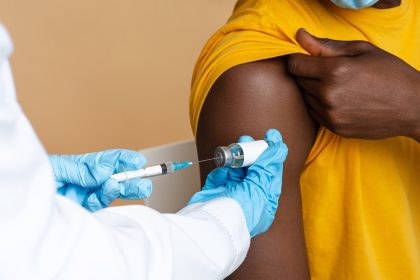You’ve been dealing with periods that turn your bathroom into what looks like a crime scene, cramps that make you double over in agony, and a belly that makes people ask when you’re due even though you’re definitely not pregnant. Every month, you’re playing Russian roulette with your calendar, never knowing when the bleeding will be so heavy that you’ll soak through a super tampon and pad in an hour, or when the pain will be so intense you can barely stand.
But when you drag yourself to the doctor’s office, desperate for help, you get the medical equivalent of a pat on the head and told that heavy periods are just part of being a woman. Maybe they hand you a prescription for birth control pills or suggest you pop some ibuprofen and tough it out. Meanwhile, you’re missing work, canceling plans, and organizing your entire life around your menstrual cycle because the symptoms are so debilitating.
What you’re likely dealing with is uterine fibroids, benign tumors that grow in and around your uterus and can turn your reproductive system into a monthly nightmare. While these growths aren’t cancerous, they can make your life absolutely miserable and lead to serious complications if they’re not properly managed. But here’s the truly infuriating part, getting doctors to take fibroid pain seriously is an uphill battle that’s even steeper if you’re a Black woman.
Your DNA stacked the deck against you from birth
Uterine fibroids have a massive genetic component, which means your family tree essentially predicted your fibroid future before you were even born. If your mother, sisters, or other female relatives dealt with fibroids, your chances of developing them shoot up dramatically compared to women without that family history.
The genetic factors influencing fibroid development affect everything from how your uterine tissue responds to hormones to how likely you are to develop multiple fibroids or growths the size of grapefruits. Some genetic variations make women more sensitive to estrogen, which acts like fertilizer for fibroid growth, while others affect the cellular processes that control tissue growth and repair.
Researchers have identified specific genetic variants that show up more frequently in women who develop fibroids, and many of these variants are found more often in certain ethnic populations. This genetic lottery helps explain why fibroid rates vary so dramatically between different groups of women and why some families seem cursed with generation after generation of women dealing with this condition.
The devastating statistics nobody talks about
The numbers around fibroids and race are absolutely staggering and deeply unfair. Black women are two to three times more likely to develop uterine fibroids than white women, and they tend to develop them at younger ages with more severe symptoms that can destroy their quality of life for decades.
By age 50, studies suggest that up to 80 percent of Black women have fibroids compared to about 70 percent of white women. But the disparities go way beyond just who develops fibroids. Black women are more likely to have multiple fibroids, larger fibroids, and fibroids that cause more severe symptoms like hemorrhage-level bleeding, excruciating pain, and pregnancy complications that can be life-threatening.
They’re also more likely to need surgical treatment and to have fibroids return after treatment, creating a never-ending cycle of medical procedures and recovery periods. These differences aren’t just about genetics either – environmental factors, chronic stress, diet, and healthcare access all combine with genetic predisposition to create a perfect storm of disadvantage.
Hormones fuel the fibroid fire
Estrogen and progesterone, the main female reproductive hormones, both influence fibroid development and growth, but the relationship is way more complicated than simply blaming hormones for causing fibroids. Some women with completely normal hormone levels develop massive fibroids, while others with significant hormone imbalances never develop them at all.
Fibroids tend to grow like weeds during periods when estrogen levels are high, such as during pregnancy or when taking certain types of hormone replacement therapy. They often shrink after menopause when estrogen levels drop significantly, which is why some doctors suggest women just wait it out until menopause – advice that’s particularly unhelpful if you’re in your twenties or thirties.
Genetic variations affect how individual women’s bodies produce, process, and respond to these hormones. Some women have genetic variants that make their bodies produce more estrogen or make their uterine tissue hyperresponsive to normal levels of estrogen. Others have variations in how they metabolize hormones, leading to higher levels of active estrogen circulating in their system and feeding fibroid growth.
The diagnostic nightmare that steals years of your life
Despite how incredibly common fibroids are, many women struggle for months or even years to get an accurate diagnosis and appropriate treatment. During this diagnostic limbo, they suffer with symptoms that can completely derail their personal and professional lives while doctors dismiss their pain as normal women’s problems.
Part of the diagnostic delay comes from the fact that fibroid symptoms often get mistaken for other conditions or brushed off as typical menstrual issues. Heavy bleeding that requires changing protection every hour gets labeled as a heavy period. Pelvic pain that makes walking difficult gets attributed to stress or being overweight. Pressure symptoms that make it impossible to sleep comfortably get dismissed as normal aging.
For Black women, diagnostic delays are often even longer and more frustrating due to well-documented healthcare disparities and provider bias. Their pain and symptoms are more likely to be minimized, dismissed, or attributed to their pain tolerance rather than being properly investigated. They may have to see multiple providers and advocate aggressively for themselves before someone takes their concerns seriously enough to order appropriate imaging studies.
Treatment access reveals ugly healthcare realities
There are actually many effective treatments for uterine fibroids available today, ranging from medications that can shrink fibroids and reduce symptoms to minimally invasive procedures that can remove or destroy fibroids while preserving fertility. However, access to these treatments varies dramatically based on factors like insurance coverage, geographic location, and the expertise of available healthcare providers.
Some of the newer, less invasive treatments like uterine artery embolization or focused ultrasound therapy aren’t available at all hospitals and require specialized training to perform safely. Women in rural areas or those with limited insurance coverage may not have access to these cutting-edge options and may only be offered more invasive surgical treatments that come with longer recovery times and greater risks.
The treatment approach also varies significantly between providers, with some being much more aggressive about recommending hysterectomy as a first-line treatment while others focus on fertility-preserving options. This variation in treatment philosophy can dramatically impact a woman’s reproductive future and overall quality of life, yet many women aren’t informed about the full range of available options.
Hysterectomy rates expose disturbing bias
Black women are significantly more likely to undergo hysterectomy for fibroids than white women, even when they have similar symptoms and fibroid characteristics. This disparity strongly suggests that Black women aren’t being offered the same range of treatment options or aren’t receiving adequate information about alternatives to surgical removal of their uterus.
Hysterectomy is sometimes genuinely the best treatment option for severe fibroids, but it’s also major surgery that permanently ends fertility and can have significant long-term health consequences including increased risk of heart disease and bone loss. When hysterectomy rates vary dramatically by race for the same medical condition, it raises serious questions about whether all women are receiving equitable care.
Some of this disparity may be related to differences in how symptoms are perceived and treated by healthcare providers, delays in diagnosis that allow fibroids to become more severe and harder to treat conservatively, or differences in access to specialized care that could provide alternatives to hysterectomy.
Pregnancy complications add another devastating layer
Uterine fibroids can significantly complicate pregnancy, causing problems like miscarriage, preterm labor, abnormal fetal positioning, and dangerous delivery complications. The location and size of fibroids influence how much they interfere with pregnancy, but even relatively small fibroids can sometimes cause serious problems that threaten both mother and baby.
Black women’s higher rates of fibroids contribute directly to disparities in maternal and infant health outcomes that persist despite medical advances. Fibroid-related pregnancy complications can lead to emergency cesarean deliveries, extended hospital stays, and increased risks for both mother and baby that compound existing healthcare disparities.
Managing fibroids during pregnancy becomes incredibly challenging because many treatments that are safe when not pregnant become off-limits during pregnancy. This means women with fibroids need specialized obstetric care and careful monitoring throughout pregnancy to identify and manage potential complications before they become life-threatening emergencies.
Finding quality care requires becoming your own advocate
If you’re dealing with fibroid symptoms, finding healthcare providers who take your concerns seriously and offer you the full range of treatment options may require serious persistence and self-advocacy skills. Don’t hesitate to seek second opinions, especially if you feel like your symptoms are being dismissed or if you’re only being offered limited treatment choices.
Research your treatment options before appointments so you can ask specific questions about procedures like uterine artery embolization, myomectomy, or newer treatments that might be appropriate for your specific situation. Consider seeking care at academic medical centers or specialized fibroid treatment centers if they’re available in your area and covered by your insurance.
Keep detailed records of your symptoms, how they affect your daily life, and what treatments you’ve tried. This documentation can help healthcare providers understand the true severity of your condition and make more informed treatment recommendations rather than dismissing your concerns as typical women’s complaints that you should just learn to live with.













